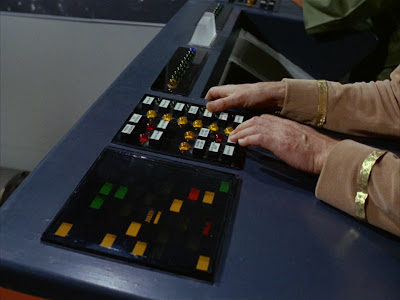Greetings from Russian trekker, this is my first post here.
In case anyone notices, and in order to prevent plagiary suspicions: this is my post from another star trek forums where I registered at the first time. Unfortunately, that community turned up to be not very alive (a single reply, lol). So I copy-pasted my post here to find out, if you trekkers are interested in real, common spaceflights.
Most of the information about Soyuz-TMA spacecraft can easily be found on the Wikipedia, here is just some interesting and 'practical' information for armchair helm officers.
"Soyuz -TMA" spacecraft consists of Orbital Module, Descent Module and Instrumentation/Propultion Module, and the descent module occupies the central part of the ship.

1. The docking unit.
2. Descend Module.
3. Transitional compartment.
4. Instrument compartment.
5. Propulsion compartment.
6. Orbital Module.
7. Exit hatch.
8. Optical/Visual device.
And here is how the cabin looks like (notice that there are more buttons here than on the TOS Enterprise helm console)


Full size (Not translated, but picture is big)
1. The integrated control panel (ICP). There are two of them on board - one is operated by Commander, other one - by first Flight Engineer.
2. Numeric keypad for inputing codes (To navigate by ICP)
3. Marker control block (To navigate by ICP)
4. Current state of systems indication panel.
5. Hand rotary valves. They are responsible for the oxygen supply.
6. Electro-pneumo-valve of oxygen supply during landing.
7. Special cosmonaut visor. During the docking, commander looks at the docking target. The visor works pretty much like a periscope on submarines.
8. Throttle control. With its help, commander gives "Soyuz- TMA" linear (positive or negative) acceleration.
9. Orientation control. With its help, commander sets the rotation of the "Soyuz- TMA" around the center of mass.
10. Refrigeration and drying unit removes heat and moisture from the ship that inevitably accumulate in the air due to the people presence on board.
11. Toggle switch space suits ventilation during landing.
12. Voltmeter.
13. Fuse box.
14. Button for conservating ship after docking. "Soyuz-TMA" is operable only for 4 days on independent flight, so the ship should be preserved. After docking power supply and ventilation are provided by ISS systems.
Looks easier than you expected, isn't it?
The information was took and translated from russian "Popular Mechanics" magazine site.
In case anyone notices, and in order to prevent plagiary suspicions: this is my post from another star trek forums where I registered at the first time. Unfortunately, that community turned up to be not very alive (a single reply, lol). So I copy-pasted my post here to find out, if you trekkers are interested in real, common spaceflights.
Most of the information about Soyuz-TMA spacecraft can easily be found on the Wikipedia, here is just some interesting and 'practical' information for armchair helm officers.
"Soyuz -TMA" spacecraft consists of Orbital Module, Descent Module and Instrumentation/Propultion Module, and the descent module occupies the central part of the ship.

1. The docking unit.
2. Descend Module.
3. Transitional compartment.
4. Instrument compartment.
5. Propulsion compartment.
6. Orbital Module.
7. Exit hatch.
8. Optical/Visual device.
And here is how the cabin looks like (notice that there are more buttons here than on the TOS Enterprise helm console)


Full size (Not translated, but picture is big)
1. The integrated control panel (ICP). There are two of them on board - one is operated by Commander, other one - by first Flight Engineer.
2. Numeric keypad for inputing codes (To navigate by ICP)
3. Marker control block (To navigate by ICP)
4. Current state of systems indication panel.
5. Hand rotary valves. They are responsible for the oxygen supply.
6. Electro-pneumo-valve of oxygen supply during landing.
7. Special cosmonaut visor. During the docking, commander looks at the docking target. The visor works pretty much like a periscope on submarines.
8. Throttle control. With its help, commander gives "Soyuz- TMA" linear (positive or negative) acceleration.
9. Orientation control. With its help, commander sets the rotation of the "Soyuz- TMA" around the center of mass.
10. Refrigeration and drying unit removes heat and moisture from the ship that inevitably accumulate in the air due to the people presence on board.
11. Toggle switch space suits ventilation during landing.
12. Voltmeter.
13. Fuse box.
14. Button for conservating ship after docking. "Soyuz-TMA" is operable only for 4 days on independent flight, so the ship should be preserved. After docking power supply and ventilation are provided by ISS systems.
Looks easier than you expected, isn't it?

The information was took and translated from russian "Popular Mechanics" magazine site.



